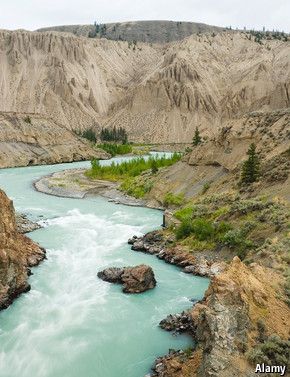 As seen on The Economist
As seen on The Economist
WHEN King George III proclaimed in 1763 that Canada’s indigenous peoples had rights to their ancestral lands, it bought peace with the locals who outnumbered and sometimes outfought the British colonists. But as the balance of inhabitants shifted—indigenous people now account for only 4.3% of the population—governments took an increasingly narrow view of that promise. In some cases they ignored it completely. On June 26th the Supreme Court of Canada provided a sharp reminder that King George’s word is still law.
The Court ruled that the Tsilhqot’in First Nation had title to 1,700 square km (650 square miles) of land in the western province of British Columbia (BC). Unlike many First Nations groups (as Canada’s indigenous Indians are known) outside BC, the Tsilhqot’in, who number about 3,500, never ceded rights through a treaty to their remote, mountainous territory. When the province’s government granted logging rights to a private company in 1983, the Tsilhqot’in fought back through the courts. The unanimous Supreme Court decision is the culmination of that battle.
The decision will have wider effects. Gordon Gibson, author of a book on Canadian Indian policy, predicts it will cause chaos and cast a pall on the development of natural resources. Ecstatic indigenous leaders think it will give them more say over resource projects across the country. The lawyer who represented the Tsilhqot’in in court noted that the proposed Northern Gateway pipeline to carry Alberta crude to the west coast, approved by the federal government in June, crosses land that could be subject to similar claims.
Although this was the first time the Supreme Court of Canada had affirmed indigenous title to a specific parcel of land, it had been inching towards this moment since 1973. That was when it recognised that indigenous title existed. Later cases clarified that the Crown did not have a pre-eminent claim on territory not covered by treaty. In its latest ruling the court said that the nomadic Tsilhqot’in could claim areas where they routinely hunted and trapped in addition to sites where they lived.
“It’s a step rather than a leap,” says Bob Rae, a lawyer and former MP who now specialises in indigenous law. The ruling applies to unceded land and not to territory covered by the numerous treaties in much of the rest of Canada. Governments retain the right to override indigenous title, but only for what the court called “compelling and substantial” objectives.
That said, companies with their eye on Canada’s natural resources have seen that indigenous groups are increasingly asserting their legal right to be consulted before development takes place on their territory. The Supreme Court helpfully pointed out that obtaining the consent of an indigenous group in advance will help governments and firms avoid a lot of legal grief.
The biggest impact is likely to be felt in BC, very little of which is covered by treaty because successive provincial governments refused to recognise the existence of indigenous title until forced to do so by court rulings in the 1990s. The BC government has been dragging its heels in treaty negotiations and opposed the Tsilhqot’in in court. Resource companies wanting certainty for their investments will now add their voices to those of the indigenous groups in seeking treaties.
Original article – The atlas of King George
